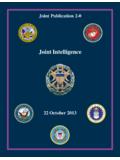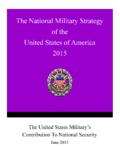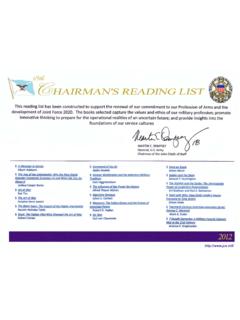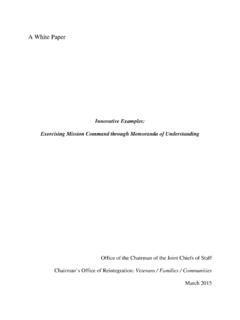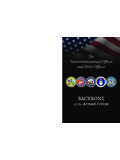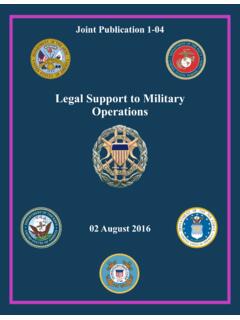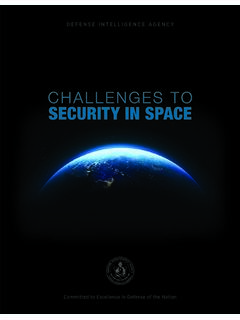Transcription of JP 2-0, Joint Intelligence - Joint Chiefs of Staff
1 22 October 2013 Joint IntelligenceJoint Publication 2-0 This revised edition of JP 2-0, Joint Intelligence , reflects the current guidance for conducting Joint and multinational Intelligence activities across the range of military operations. This vital keystone publication forms the core of Joint Intelligence doctrine and lays the foundation for our forces ability to fully integrate operations, plans, and Intelligence into a cohesive team. The overarching constructs and principles contained in this publication provide a common perspective from which to plan and execute Joint Intelligence operations in cooperation with our multinational partners, other US Government agencies, and intergovernmental and nongovernmental organizations.
2 As our Nation continues into the 21st century, Joint Intelligence organizations and capabilities will continue to evolve as our forces transform to meet emerging challenges. The guidance in this publication will enable current and future leaders of the Armed Forces of the United States to organize, train, and execute worldwide missions to counter the threats posed by adaptive adversaries. I encourage all leaders to study and understand the doctrinal concepts and principles contained in this publication and to teach these to your subordinates. Only then will we be able to fully exploit the remarkable military potential inherent in our Joint teams. To that end, I request you ensure the widest possible distribution of this keystone Joint publication.
3 I further request that you actively promote the use of all Joint publications at every opportunity. MARTIN E. DEMPSEY General, Army i PREFACE 1. Scope This publication is the keystone document for Joint Intelligence . It provides fundamental principles and guidance for Intelligence support to Joint operations. 2. Purpose This publication has been prepared under the direction of the Chairman of the Joint Chiefs of Staff (CJCS). It sets forth Joint doctrine to govern the activities and performance of the Armed Forces of the United States in Joint operations and provides the doctrinal basis for US military coordination with other US Government departments and agencies during operations and for US military involvement in multinational operations.
4 It provides military guidance for the exercise of authority by combatant commanders and other Joint force commanders (JFCs) and prescribes Joint doctrine for operations, education, and training. It provides military guidance for use by the Armed Forces in preparing their appropriate plans. It is not the intent of this publication to restrict the authority of the JFC from organizing the force and executing the mission in a manner the JFC deems most appropriate to ensure unity of effort in the accomplishment of the overall objective. 3. Application a. Joint doctrine established in this publication applies to the Joint Staff , commanders of combatant commands, subunified commands, Joint task forces, subordinate components of these commands, the Services, and combat support agencies.
5 B. The guidance in this publication is authoritative; as such, this doctrine will be followed except when, in the judgment of the commander, exceptional circumstances dictate otherwise. If conflicts arise between the contents of this publication and the contents of Service publications, this publication will take precedence unless the CJCS, normally in coordination with the other members of the Joint Chiefs of Staff , has provided more current and specific guidance. Commanders of forces operating as part of a multinational (alliance or coalition) military command should follow multinational doctrine and procedures ratified by the United States. For doctrine and procedures not ratified by the United States, commanders should evaluate and follow the multinational command s doctrine and procedures, where applicable and consistent with US law, regulations, and doctrine.
6 Preface ii JP 2-0 Intentionally Blank iii SUMMARY OF CHANGES REVISION OF Joint PUBLICATION 2-0 DATED 22 JUNE 2007 Clarified the term Intelligence interrogation and provided specific publications for guidance. Explained the Joint Intelligence process and rewrote the section to better develop its characteristics. Added the term sociocultural analysis (SCA). The phrase other relevant actors was included in the SCA explanation to cover not only direct adversaries, but any person or group that may aid the adversary. Added a description of identity Intelligence and grouped it under production categories. Added the definition collection strategy and modified the terms collection plan and collection requirement.
7 Changed the term indication and warning to warning and modified the definition of warning. Clarified the distinction between the term red cell and red team. Summary of Changes iv JP 2-0 Intentionally Blank v TABLE OF CONTENTS EXECUTIVE SUMMARY .. ix CHAPTER I THE NATURE OF Intelligence Introduction .. I-1 The Roles and Responsibilites of Joint Intelligence .. I-3 The Joint Intelligence Process .. I-5 Intelligence and the Levels of War .. I-23 Intelligence and the Range of Military Operations .. I-25 The Role of Intelligence in Military Operations .. I-27 CHAPTER II PRINCIPLES OF Joint Intelligence Introduction ..II-1 Perspective ..II-1 Synchronization Synchronize Intelligence with Plans and Operations.
8 II-2 Integrity Remain Intellectually Hones ..II-3 Unity of Effort Cooperate to Achieve a Common Objective ..II-4 Prioritization Prioritize Requirements Based on Commander s Guidance ..II-6 Excellence Strive to Achieve the Highest Standards of Quality ..II-6 Prediction Accept the Risk of Predicting Adversary Intentions ..II-9 Agility Remain Flexible and Adapt to Changing Situations ..II-10 Collaboration Leverage Expertise of Diverse Analytic Resources ..II-11 Fusion Exploit All Sources of Information and Intelligence ..II-12 CHAPTER III Intelligence ORGANIZATIONS AND RESPONSIBILITIES Defense Intelligence and the Intelligence Community .. III-1 Defense and Joint Intelligence Organizations.
9 III-6 Intelligence Federation .. III-9 Command and Staff Intelligence Responsibilities .. III-9 CHAPTER IV Intelligence SUPPORT TO PLANNING, EXECUTING, AND ASSESSING Joint OPERATIONS SECTION A. Intelligence PLANNING Overview .. IV-1 SECTION B. Joint OPERATION PLANNING Joint Operation IV-2 Table of Contents vi JP 2-0 SECTION C. THE Intelligence PLANNING PROCESS Intelligence Planning Lines of Effort .. IV-2 Intelligence Planning Activities During Strategic Guidance .. IV-4 Intelligence Planning Activities During Concept Development .. IV-7 Intelligence Planning Activities During Plan Development .. IV-8 SECTION D. PLAN ASSESSMENT AND EXECUTION Intelligence Support to Plan Assessment and Decision Making.
10 IV-9 Intelligence Support to the Assessment Process .. IV-10 Intelligence Support to Strategic and Operational-Level Assessment .. IV-12 Tactical-Level Assessment .. IV-14 SECTION E. Intelligence SUPPORT TO EXECUTION BY PHASE General .. IV-17 Intelligence Support During the Shape Phase (Phase 0) .. IV-18 Intelligence Support During the Deter Phase (Phase 1) .. IV-19 Intelligence Support During the Seize the Initiative Phase (Phase II) .. IV-21 Intelligence Support During the Dominate Phase .. IV-22 Intelligence Support During the Stabilize Phase .. IV-22 Intelligence Support During the Enable Civil Authority Phase .. IV-24 CHAPTER V Joint , INTERAGENCY, AND multinational Intelligence SHARING AND COOPERATION An Intelligence Sharing Environment.
